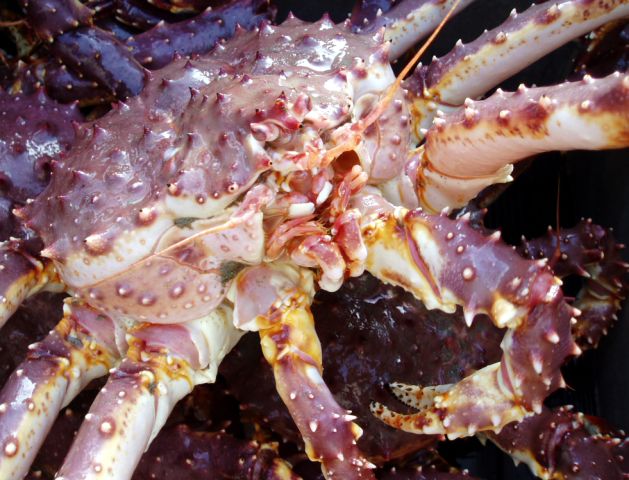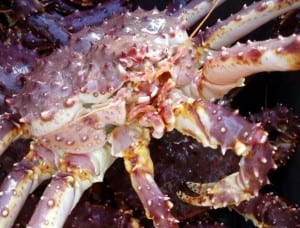Commercial crabbers will not have a season for red and blue king crab in Southeast again this year. The fishery was opened last year, for the first time in six years. However, the Alaska Department of Fish and Game says red king crab stocks are now at their lowest levels in over two decades.
The state can open Southeast’s red king crab season if the estimated amount of legal size, male king crab tops a minimum threshold of 200,000 pounds. Fish and Game conducts an annual survey of crab stocks and this year estimates the available crab for harvest is not even 10 percent of that minimum, at 15-thousand 600 pounds.
Joe Stratman, the department’s regional shellfish project leader, noted a drop in the number of recruits, or crab maturing to a large enough size to be kept in a commercial fishery. “I think generally the current stock assessment survey showed much lower levels of pre-recruit and recruit catch per unit effort for all surveyed areas than was exhibited in the previous years survey,” Stratman said. “This provided much smaller mature and legal biomass estimates.”
The department estimates the region’s overall biomass of mature male red king crab is under a million pounds, and is down by more than a third from last year. Fish and Game surveys nine bays and waterways in central and northern Southeast normally fished by the crab fleet, and uses historical catch data to come up with crab estimates. The department says their survey this year shows stock health is poor in five of the surveyed areas. The department and the crab fleet are also in the third year of a collaborative effort to use a different method for estimating crab numbers. That involves catching crab, marking and recapturing them. Last year that collaborative study resulted in an adjustment upward for crab stocks in some of the surveyed areas and a large enough overall estimate to open the fishery. Even with the adjustment this year for seven of the surveyed areas, the estimate remained too low for a fishery.
“In surveyed areas that were open in the last year to commercial and personal use fishing, there were reductions in the mature male biomass estimates,” Stratman said. “In surveyed areas that were closed to commercial and personal use fishing in 2011, mature male biomass estimates did not improve, they stayed about the same.”
Last year’s catch topped 176,000 pounds, landed by 54 permit holders. Averaging more than 10 dollars a pound last year, the crab was worth one point 87 million dollars at the docks. When it’s open, the November fishery is an important economic boost for Southeast’s fishing fleet.
“Well I think we have a stock that’s right on the edge of threshold each year and it’s important to keep an eye on it by doing all the surveys we do and when we have an opportunity to utilize this crab, we need to take advantage of that, mainly because of the economic benefit it brings to the coastal communities in a time of year, November when we don’t have a lot going on and it’s a real boon for the economy locally,” said Randy Lantiegne, fleet manager at Icicle Seafoods in Petersburg.
Crabbers in the past have contested the state’s crab stock survey and argue that crab are more plentiful than the department estimates. Fleet input has led to changes to the annual department survey along with the collaborative effort to gauge crab numbers.
Julianne Curry, the outgoing executive director of the Petersburg Vessel Owners Association, says the news is disappointing. “You know judging by how well some of the surveys have been going guys were definitely thinking that they were going to see a fishery this year but if the science doesn’t back it up then the science doesn’t back it up and that’s what we’re gonna have to accept for this year,” Curry said. “Now of course the survey efforts are ongoing and the vessel owners is a critical part of ensuring those surveys continue to occur and the fishermen are doing a great job of coordinating with the department and we’ve established a great working relationship we’re very excited for what we can accomplish in the future but it looks like this year it’s just not in the cards.”
The low crab estimates also mean some closed areas for personal use crabbing and reductions in bag limits for the areas that remain open.











